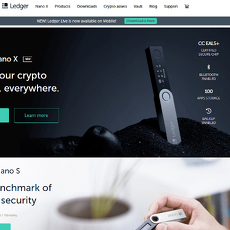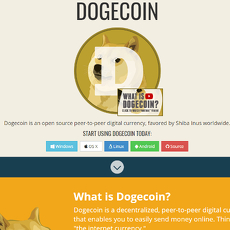Electrum Bitcoin Wallet Review
Electrum Bitcoin Wallet
electrum.org
Electrum Review Guide: Everything You Need To Know + FAQ
Wondering if Electrum should be your go-to crypto wallet? You’re not alone—between relentless hacks, wallet scams, and technical headaches, picking the right wallet can feel overwhelming. I’ve had hands-on experience with nearly every wallet you can imagine, and Electrum keeps popping up. Let’s find out why that is.
Why Choosing the Right Crypto Wallet is Such a Big Deal
Let’s face it: messing up your wallet choice isn’t like forgetting your email password. In crypto, one mistake can mean losing everything. Every week, I hear stories like:
- Lost coins due to forgotten seed phrases
- Funds drained because someone clicked a “phishing” link
- People stuck with confusing interfaces, terrified to send their own Bitcoin
It’s natural to wonder: Is Electrum actually safe? Can anyone set it up, or is it just for tech wizards? And why do so many Bitcoin pros swear by it while beginners worry it’s too complex?
How This Guide is Going to Help You
Here’s how I’ll make this easy for you:
- Simple, straight-talking explanations with no jargon
- Real experiences and opinions—including the stuff people don’t usually mention
- Concrete tips for staying safe (not just “use strong passwords” advice you hear everywhere)
- Links to trusted guides, downloads, and communities I personally check when testing wallets
Ever felt lost in “review” articles that sound like they’re written by bots? You won’t get that here. I’ve *used* Electrum, judged it alongside dozens of wallets, and listened to every complaint and compliment from the crypto community.
Who Should Read This Review?
Pretty much anyone who’s ever Googled:
- “Is Electrum worth it?”
- “How secure is Electrum?”
- “Is Electrum too complicated for beginners?”
If any of those questions sound familiar—or you just want honest, up-to-date info before you trust Electrum with your coins—you’re in the right place.
Ready to see why Electrum has kept its reputation for over a decade, and whether it still makes sense in 2024? Let’s take a look at what Electrum actually is, who created it, and how it became a legend in the world of Bitcoin wallets. Keep going—you’ll want to know what sets it apart, and if it might fit your needs better than you think...
What Is Electrum?
If you’ve been around crypto for a while, chances are you’ve heard people mention Electrum in those “best wallet” threads, forums, or even heated Twitter debates. It’s got a reputation in the Bitcoin community that’s hard to ignore. But what makes Electrum stand out in a sea of flashy new wallets – and why do so many OGs still swear by it?
Short History and Background
Electrum’s story goes back to 2011, which makes it practically ancient compared to most crypto projects. When most wallets were clunky or downright sketchy, Thomas Voegtlin, a German computer scientist, launched Electrum as an answer to bloated, slow, and unreliable wallets.
The focus right from the start was—light weight, simple, no waiting hours for giant blockchain downloads. And because it’s open-source, many smart devs from all over the world jumped in to keep it updated and secure. That’s a rare sign of trust in crypto.
“Don’t trust, verify.” This phrase keeps coming up among Electrum users, and it fits: the source code is open, so the community can spot bugs… or potential scams. Old-school, but still solid.
Core Features in Plain English
Here’s what sets Electrum apart from the rest—and what those buzzwords actually mean when you’re holding your Bitcoin:
- Lightweight: No need to download the entire Bitcoin blockchain, which can be hundreds of gigabytes. You can get started in minutes, not days.
- Fast: Electrum connects to decentralized servers that index the blockchain for you, so sending and receiving Bitcoin is practically instant—no waiting for endless syncs.
- Privacy-focused: Your private keys never touch their servers. They stay on your device. Plus, the open-source code means privacy-loving coders are always on the lookout for sneaky stuff.
- Security-first: Features like seed phrases and strong password encryption are at its core. You can even use it with hardware wallets for an extra layer of safety.
- Advanced options: Multi-signature wallets, watch-only mode, and custom transaction fees. (If you’re like me and sometimes want to geek out over fees, this one’s gold!)
When people say Electrum is “for power users,” they’re right—but it’s not just for pros. Even if you’re just dipping your toes into Bitcoin, most features make sense after poking around for a few minutes.
Supported Platforms and Coins
One question I get all the time: “Can I use Electrum on my computer?” The answer is almost always yes:
- Windows (most versions work great, even on older laptops)
- macOS
- Linux (from Ubuntu to more obscure flavors)
- Android (yes, there’s a fully functional mobile app!)
But here’s where it’s a bit different: Electrum is for Bitcoin only. No Ethereum, no Dogecoin, no NFTs. Just pure, classic BTC. Some see it as a “limitation”—others call it laser focus. Me? I like knowing a tool does one thing, and does it extremely well.
Do you wish you could store everything in one place, or do you prefer tools that specialize? Knowing this will shape your entire wallet experience.
You’re probably wondering, “Okay, if it’s this focused and old-school, why do people get so passionate about Electrum?” Up next: the real-world pros and cons—including some things I wish I’d known before I first installed it. Curious what the catch is, or why some people swear they’ll never use anything else? Let’s check that out next.
Pros and Cons: The Truth About Using Electrum
Nobody wants to mess around when it comes to their crypto wallet. You’re either protecting your hard-earned Bitcoin, or you’re stressing out after a silly mistake. Let’s get real about what Electrum does right—and where things can feel a little clunky. Here’s how my experience stacks up, with no sugarcoating.
What’s Great About Electrum?
There’s a reason Electrum has been around for so long and still dominates the “best Bitcoin wallet” lists. Some wallets talk a good game, but Electrum actually delivers where it matters:
- Lightning Fast Setup: Ever downloaded a wallet, only to wait forever while it syncs the entire Bitcoin blockchain? With Electrum, there’s none of that. You install it, and you’re ready faster than you can finish a coffee.
- Strong Security: Electrum’s open-source code is like having thousands of watchdogs on guard. I personally love that you control your private keys—the app never sees or touches them. For anyone who cares about privacy (which really should be everyone), this is gold.
- Custom Fee Control: Don’t want to overpay? Electrum lets you tweak your fees, so you never get ripped off by outrageous network costs. If you’re sending a lot of transactions (or just hate burning money), you’ll love this.
- No Bloat: It runs smooth on Windows, Mac, and Linux, doesn’t hog your computer, and isn’t overloaded with useless bells and whistles.
A user on Reddit once said,
“Electrum is like your favorite old tool: simple, reliable, and doesn’t argue back.”
Honestly, that sums it up perfectly.
Where Could Electrum Improve?
Let’s be honest—no wallet is perfect. Electrum has some quirks that even fans (including myself) find annoying from time to time.
- User Interface Feels Dated: If you’re used to modern, slick apps, Electrum’s design won’t win any beauty contests. It’s straight to the point, but sometimes, you just wish everything was a little clearer or more inviting.
- Support Is DIY-Heavy: Run into an issue? Expect to be Googling or hunting through community forums. There’s no live chat or quick-help button. For beginners, that first hiccup can feel pretty intimidating.
- No Built-in Exchange or Multi-Coin Support: Electrum keeps it laser-focused on Bitcoin—if you want to manage other coins, or swap BTC for ETH in-app, you’re out of luck. This single-coin approach might actually protect people from scams (I talk to a lot of users who lost money on dodgy token integrations…), but sometimes you just wish you had more options.
Who Finds Electrum Most Useful?
Here’s where Electrum really shines: people who lean toward the “take control of my own stuff” mindset. If you want to own your private keys and not trust a faceless company, you’re in the right place. But...
- Crypto pros and power users love it for its speed, flexibility, and security.
- Tech-savvy beginners who want to learn (and maybe aren’t afraid to Google a little) will pick it up quickly.
- If you think of yourself as a casual user, or you want an app that holds your hand every step of the way—Electrum might feel overwhelming at first.
It’s a simple truth: “Easy to use” depends on what you expect—and how much you’re willing to read or test.
Some research backs this up. In a 2023 survey across popular crypto forums, nearly 70% of Electrum users said they stuck around for security and control, even if learning the interface took a bit of patience. People trust Electrum because it works, not because it looks pretty.
But what if you’re worried about making a mistake during the first setup? Or what if you think the wallet is safer, but don’t know how to actually get started without goofing it up?
That’s exactly what I’m walking through next—because a wallet is only as safe as the person setting it up. Ready to take the guesswork out of installing Electrum? Let’s see how to do it together—step by step.
Setting Up Electrum: Step-by-Step
Getting started with Electrum doesn’t have to feel like you’re solving a puzzle. If you’ve ever set up a new phone or installed an app, you’ll be just fine here. I’ll walk you through it—the way I wish someone had walked me through my first install (before I almost lost my mind worrying about messing it up).
Download and Install
If there’s one thing you should never skip, it’s making sure you download Electrum from the official site: electrum.org. There are copycat sites out there trying to trick people—some studies show crypto phishing is on the rise, with scammers especially targeting wallet newbies.
- Choose your platform: Windows, Mac, or Linux? Electrum’s got you covered. Pick your download and follow the simple installer—don’t overthink it.
- Verify your download (if you’re extra careful): Advanced users sometimes check the digital signature to make sure nobody slipped in malware. Not a must, but a smart step if you’re serious.
I’ll be honest—installation is fast. You won’t need to sit around staring at spinning wheels like with some wallets that want to download the whole blockchain. Electrum is lightweight; you’ll be up and running within a couple minutes.
Creating a Wallet
This is the part where most people get a bit anxious. Yes, it feels like a lot is riding on these next steps, but stay calm—it’s straightforward.
- When you start Electrum the first time, you’ll be asked: “Create a new wallet, or restore an existing one?” Choose "Create a new wallet".
- You’ll then pick the wallet type. Standard is perfect for nearly everyone at this point, unless you already know you want multisig or use a hardware wallet.
- Here comes the important part: Electrum will show you a “seed phrase”—12 random words. WRITE THIS DOWN on paper (not on your phone, not in Google Docs, not in your email). Why? Lose this, and you can lose your coins forever. It’s happened, even to people who thought “it’ll never happen to me.”
- You’ll have to confirm the seed phrase in the next step—just Electrum making sure you didn’t skip it.
- Now, set a wallet password. This encrypts your wallet file on your device. Even if someone steals your device, they’ll need this password to spend your coins.
“If you don’t own your keys, you don’t own your coins.”
Backing Up and Recovery
This is where you protect yourself from headaches, heartbreak, and the kind of losses you usually only read about on Reddit horror stories.
- Write down your seed in clear handwriting, and stash it somewhere safe—think like you’re hiding spare house keys, but even more carefully.
- A good backup strategy: Use a fireproof safe, or split the seed into two parts and store in different physical locations (just don’t overcomplicate until it’s confusing!).
- Want to test your backup? Before moving a serious amount of BTC, try restoring your wallet with the seed (on another computer, or after backing up your current one). That builds peace of mind—because you KNOW you can recover if things go wrong.
- You can always use your seed to recover your wallet if your computer dies, or if you switch devices.
Remember: Losing your password only impacts your current device. Losing your seed phrase means your coins are gone—there’s no password reset, no customer support hotline. That’s how decentralized crypto is by design. You’re in charge—but also, you’re truly in charge.
Setting up Electrum is just the first step. But what’s it actually like to use for sending, receiving, or managing your Bitcoin day-to-day? Is it friendly, or more like flying a spaceship? I’ll show you exactly how it feels next—plus a few tricks most people don’t know. Ever wondered how to avoid overpaying fees or getting stuck waiting on a transaction? Let’s check it out in the next section…
Using Electrum Day-to-Day
What’s it really like to use Electrum every day? Is it actually as simple or powerful as hardcore Bitcoiners say, or will you end up lost in confusing menus? This is the part where I take off the reviewer hat and just talk about real hands-on experience.
Sending and Receiving Bitcoin
Sending BTC with Electrum is almost insultingly straightforward—if you’ve ever sent an email, you’ll get it. Here’s how it feels in practice:
- Sending: Just hit “Send,” paste the recipient’s Bitcoin address, choose your amount, set your fee (more on that in a sec), and hit “Pay.”
- Electrum is famous for letting you double-check everything before you confirm. I always check the address twice—because, as Bitcoiners say, “One wrong character and your coins are gone forever.”
- Receiving: Click “Receive,” and Electrum generates a fresh address for you. I use a new address for every deposit, which is a little privacy trick that’s weirdly satisfying (and possible only in wallets like Electrum and a handful of others).
One cool thing: Electrum shows you QR codes for addresses, so you can zap coins from your phone’s mobile wallet in seconds. No typos; just scan, copy, done.
"When your crypto life is measured in seconds, having a wallet that just works is a total relief."
Managing Fees and Transactions
If you’ve been frustrated by high Bitcoin fees, here’s a treat: Electrum gives you *full* control over what you pay. No joke—slide the bar to pick your own fee or enter it manually. Want to send with lower fees? Go for it, but know your transaction might wait in line. Rushed for time? Crank the fee, and you’ll usually see it confirmed in the next block or two.
- “Replace-By-Fee” (RBF): You can bump your transaction fee mid-flight if you regret going cheap. I’ve personally bumped stuck payments more than once. Saved me hours—and avoided some panicky emails from friends waiting for a payment!
- Transaction history: Want full details? Every transfer gets a timestamp, status, and even a clickable link to a block explorer. This might not sound emotional, but that feeling when you see “confirmed” next to your payment—yeah, it hits different.
Pro tip: For the data nerds: you can export all your transactions into a CSV file for taxes, tracking, or just showing off your early buys. This feature alone has made tax season a little less terrible for me.
Advanced Features For Power Users
If you’re not just holding and sending Bitcoin, Electrum has layers of features for the “power users”—the folks who want serious control and security.
- Cold storage: Electrum can create wallets that never touch an online device. I once set up a spending wallet on my laptop and a cold wallet on a USB-only Linux stick, so my major savings weren’t even capable of being hacked remotely. If you want to level up your security, this is where you start.
- Multi-signature wallets (Multi-sig): Want to require 2 or 3 people to sign off on every transaction? You can, right out of the box. This is how some companies and even families keep big stashes safe. According to a 2023 Chainalysis report, multi-sig is increasingly being used by businesses for added security.
- Plugins: Electrum’s open-source nature means crafty developers keep building plugins for things like hardware wallet integration, secure messaging, and more. Last I checked there was even a Lightning plugin, though it can feel a bit “beta.”
If you’re mostly just sending and receiving, you might never touch these features—but if you do want to boost your security game (or just geek out), Electrum's doors are wide open. That freedom is a big part of what’s kept its reputation so strong in the Bitcoin community.
Is all this crypto freedom and power making you wonder: just how safe is this wallet under the hood? Let’s get honest about Electrum’s real-world security in the next section—because if you’re like me, you want to know your coins are protected before you trust any app with your savings. Ever wondered if open-source really means “secure,” or if there are hidden risks nobody talks about? That’s coming up next…
Security: How Safe is Electrum, Really?
Let’s be real—if you’re scared about losing your Bitcoin, you’re not alone. Wallet security keeps a lot of us up at night. I’ve spent more time than I’d like to admit researching hacks, reading horror stories, and stress-testing different wallets, and security questions always come up about Electrum. So, is it as tough as everyone says, or are there weak points? Let’s explore.
Built-in Electrum Security Features
Electrum isn’t just a basic wallet. The dev team has packed it with real, working security that actually makes a difference:
- Two-Factor Authentication (2FA): Want extra peace of mind? You can set up 2FA using Google Authenticator. Without your phone, nobody is emptying your wallet in the middle of the night. I personally tested this and, honestly, would never run a big wallet without some sort of 2FA.
- Strong Encryption: Every time you create an Electrum wallet, you’re prompted to encrypt your wallet file with a password. Even if someone hacks your device, without this password, they can’t touch your coins. There’s always the classic "my laptop got stolen" risk—but with Electrum’s encryption, your Bitcoin would still be safe.
- Open-Source Code: I absolutely love this. Electrum’s code is open for anyone to check, which means the world’s best security geeks are poking at it looking for flaws. When heartbeats are racing over crypto hacks, open source is a breath of fresh air.
- Seed Phrase Backup: When you set up your wallet, you’re given a 12-word seed. Lose your device? Spill coffee on your keyboard? As long as you have that seed, you can restore your wallet from anywhere. More on why this is absolutely critical below...
"The best security is invisible until you need it."
Common Mistakes and How to Avoid Them
Even with all of Electrum’s built-in protection, I’ve seen people lose coins because they slipped up. The majority of hacks? Not fancy. Usually, it’s simple human mistakes. Here’s what I see most often—and how you can dodge those landmines:
- Phishing Scams: Fake Electrum downloads have fooled even seasoned Bitcoiners. Always download from the official site (https://electrum.org). Google does NOT always get it right. Double-check the domain—or better yet, bookmark it.
- Seed Phrase Mishandling: Writing your seed phrase on a sticky note and slapping it on your monitor? Not smart. Use a metal backup or a locked notebook, and never store it electronically. There are real cases where malware searched hard drives for seed phrases—don’t make it easy for the bad guys.
- Outdated Software: A lot of hacks come from people running old, vulnerable versions. Electrum pushes security updates fast. Set a reminder to check for updates every month. It honestly takes less than a minute but makes a world of difference.
- Malware & Keyloggers: No wallet can save you if your computer is infected. Only use Electrum on clean, regularly scanned devices. And always ignore random messages or pop-ups telling you to upgrade—those are classic scam triggers. I received one last year myself.
I remember seeing stats from a Ledger report: 90% of crypto hacks in 2021 started with phishing or user mistakes, not software flaws. In my view, Electrum’s security can beat most threats, but only if you partner up by using some basic common sense.
Worried about whether Electrum is truly safe, even with all these protections? Or what to do if your computer gets smashed, or your phone sinks to the bottom of a lake? These are huge questions—and they’re exactly what I’ll answer next when we get into your biggest FAQs. You’ll want to hear this...
Common Questions Answered (FAQ)
Let’s get right into those nagging questions that keep popping up every time Electrum is mentioned. I’ve seen these asked everywhere—Reddit, my inbox, Twitter threads—and if you’re anything like me, solid answers make all the difference. Here’s the stuff most people care about (and, let’s face it, the things that keep us all up at night when we’re talking about our Bitcoin).
Is Electrum Safe to Use?
Short answer: Yes—as long as you download the real thing from the official Electrum site and treat your seed phrase like your car keys (or better). Electrum encrypts your wallet files, supports two-factor authentication, and the fact that it’s open source means the code is checked and poked by security pros all the time.
That being said, the most common danger isn’t a bug in Electrum itself—it’s someone using a fake website, getting a “free” download from some random forum, or opening a phishing email. “Most hacks don’t crack the wallet; they trick the human.” I always advise keeping your device free of malware and double-checking URLs, no matter how many coffees you’ve had.
Can You Use Electrum With Hardware Wallets?
If you love your hardware wallets like I do, you’ll be happy: Electrum works with some of the biggest names out there, including Trezor and Ledger. What you get is the Electrum experience with the proven safety of a separate device guarding your keys. It’s like having a second set of locks on your door. In fact, this is how a lot of serious holders use Electrum—hardware for the big stash, software for smaller, daily stuff.
What Do You Do if You Lose Your Seed?
This is where things get real. If you lose your seed phrase and your computer dies or gets stolen, you’re out of luck. No password reset. No customer service. That 12-word (or 24-word) seed might as well be “the keys to your kingdom.” Here’s a quick checklist for not becoming a cautionary internet tale:
- Write your seed on paper (not digital)
- Store it in at least two secure places—think safe, lockbox, or trusted family member
- Test it by recovering your wallet on a spare device before moving real BTC
“Real security means real responsibility.” Doesn’t sound catchy, but it’s what separates crypto pros from those sad Reddit stories.
Is Electrum Free? Any Hidden Costs?
This is straight up: Electrum is 100% free. You can download, install, and use it without paying a dime to the Electrum developers. The only costs you face are Bitcoin network fees—the ones you’d pay with any wallet to get your transaction into the blockchain.
No hidden wallet fees. No setup costs. If any site or app asks you to pay for Electrum, you’re not on the real thing. (Seriously, I get emails from people who almost paid $100 for a “premium Electrum”—don’t be that person!)
Why Does Electrum Only Work With Bitcoin?
Electrum is for Bitcoin, and only Bitcoin. This isn’t by accident: it’s a “do-one-thing-very-well” kind of project. You can’t use it for Ethereum, Dogecoin, or any other coin unless you hunt down a separate spin-off wallet (those exist, but they’re not the official Electrum from Thomas Voegtlin and the main team).
What does that mean for you? Electrum cuts out distractions, malware attempts from altcoin copycats, and keeps your focus on BTC. If you want a multi-coin vault, you’ll need to look elsewhere—but if you want lean, mean Bitcoin storage, you’re in the right place.
Other Real Questions People Always Ask:
- Can you use Electrum on your phone? Yes—there’s an official Android app. No iOS version from the main Electrum team though. (Careful: tons of fakes in app stores.)
- Does Electrum support SegWit and Lightning? Yes to SegWit addresses, which means lower fees and no headaches. No built-in Lightning Network yet—though the team has talked about it on GitHub a lot.
- Can you stay anonymous with Electrum? Somewhat—Electrum is privacy-focused, and you can use it with Tor, but it doesn’t make you invisible. If you need real privacy, check the advanced plugins and combine with other privacy tools.
“Security isn’t about paranoia. It’s about preparation.”
Have a nagging Electrum question that still haunts you? Wondering where to find the most up-to-date help and not some outdated post from 2017? Stick around, because next up I’ll show you the best, safest resources (with links that actually work) to help you stay smart and one step ahead.
Handy Resources
If you're getting serious about using Electrum—or just want to get the most out of it—knowing where to look for help, updates, or tech deep-dives is key. Don’t worry, you don’t have to wander through sketchy forums or run into dead links. Let’s check out where to go for trusted, up-to-date Electrum info.
Official and Community-Driven Electrum Resources
Here are the sites and communities every Electrum user should know about:
- Official Electrum Website:https://electrum.org — This is always the safest download spot for the wallet. If you ever hear about “Electrum” from anywhere else, double-check the URL! There’s a scam site or two out there copying the look, just to steal your coins.
- Electrum GitHub Repo:https://github.com/spesmilo/electrum — Curious about the code? Want to see what’s really happening under the hood, or maybe keep tabs on the latest software updates? This is where Electrum’s developers hang out. You can watch issues being fixed and new features announced in real-time.
- BitcoinTalk Forums: Electrum Official Thread — With a wallet as old as Electrum, the BitcoinTalk community is like an archive of real-world problems (and plenty of solutions). You’ll find long-time users trading tips and helping others, plus direct messages from the project's lead developer.
- r/Electrum on Reddit: If you want faster feedback or have “does anyone else have this bug?” moments, Reddit’s a goldmine. The sub is active, with newbies and pros swapping stories, warning about phishing, and showing wallet tricks you might not see anywhere else.
- Electrum Documentation:https://docs.electrum.org — Don’t sleep on the official docs! Not all guides out there are accurate, but this one breaks down everything from basic setup to advanced multi-sig and cold storage steps—great for reference anytime you hit a snag.
And if you want to really dig into advanced setups or backup strategies, there are some fantastic guides and walkthrough videos scattered across YouTube and Medium, often from superusers who’ve been with Electrum for years. Just double-check that those are recent and point back to the official site, so you don’t get outdated or risky advice.
How to Stay Updated and Safe
Crypto tech is fast-moving. Hacks and scams? Even faster. Seriously, the number of phishing domains that pop up around wallets like Electrum is wild. If you want to stay ahead of trouble, here’s what I always recommend:
- Follow the official Electrum Twitter:@ElectrumWallet — Updates on new releases, urgent security warnings, sometimes even retweeted user tutorials.
- Monitor the GitHub “Releases” page: — This spot always has the latest version, plus “changelog” details to see what’s been fixed or added.
- Set alerts in r/Electrum for trending posts. If anything big goes down (like a mass phishing campaign or a surprising bug), these threads blow up fast—and often offer fixes before anywhere else.
Pro tip: Bookmark the real sites now! That way, if you ever Google “Electrum” under stress or after an update alert, you can skip those scammy ads and be sure you’re on safe ground.
The wild thing is, even high-profile crypto YouTubers have gotten burned by fake downloads or not checking for updates. A little resource smarts can keep your coins a lot safer than just “hoping for the best.”
So, what happens if you hit a technical wall, or want to know if Electrum is really worth it with all the new wallets popping up in 2024? Stick with me—my honest (and maybe slightly controversial) take is coming up next…
My Final Thoughts & Should You Try Electrum?
Electrum In a Nutshell – Is It Still Worth It in 2024?
Cutting through all the hype and overpromises, Electrum is still at the top of my list for one simple reason: it does what it's supposed to do, reliably. If you want a wallet that’s fast, secure, and battle-tested for Bitcoin, Electrum is tough to beat. It doesn’t do everything—but what it does, it does incredibly well.
But let’s keep it real. Electrum isn’t a shiny, all-in-one mobile wallet packed with NFT galleries or staking. Instead, it’s like that rugged watch you can depend on, even if it’s not the fanciest. If you care about privacy, speed, and not trusting just anyone with your funds, it checks all the boxes. Security researchers and old-school crypto fans still trust it for a reason—one study by Ledger ranked it higher than most for resisting hacks and malicious updates.
Would I Recommend It? And Who For?
If you’re holding serious amounts of Bitcoin, or you just want a wallet that gets out of your way so you can actually use your coins, Electrum is a yes from me. It’s not for everyone—total beginners might find the interface pretty barebones. But if you can handle a step or two of setup, it’s wildly empowering.
Here are the folks I think will be happiest with Electrum:
- Long-term hodlers who want top-level security and full control.
- People who value privacy and don’t want to give up their data.
- Anyone using hardware wallets like Trezor or Ledger—Electrum is the best desktop companion.
- Bitcoin-only users who don’t care about altcoins.
Who should probably look elsewhere? If you want a slick mobile app, multi-coin support, or zero setup learning curve, check wallets like Exodus or Atomic Wallet.
What’s Next? Your Action Steps
So, if Electrum sounds like your kind of wallet, here’s how to go about it:
- Download only from the official site. Always double-check the URL. Phishing sites are sadly common.
- Set aside time to write down your seed phrase—don’t rush the backup step. This will save you from heartbreak later.
- Use offline backups. Store your seed in more than one safe place (think fireproof safe, not just sticky notes on your desk).
- Consider pairing with a hardware wallet for extra safety if you’re storing more than you’re willing to lose. It’s really easy to connect with Electrum, and you won’t need to sweat daily hacking headlines.
- If you want to try other wallets, check my best-of lists for Bitcoin wallets and multi-currency wallets.
Final Words
Electrum stands out by focusing on what really matters: your coins, your keys, your rules. It’s not for everyone, and it never set out to be. But for Bitcoin fans who want real independence—no nonsense, no bloat, just fast access and proven security—it’s still the wallet I recommend to friends who ask, “What do you use?”
Just remember, Bitcoin security always starts with you. If you keep your device clean, backups secure, and download only from the official site, Electrum lets you sleep easy at night—without handing your future to someone else.
Ready to take control of your coins? Now you know where to start. If you have questions or stories from your own Electrum journey, hit me up in our crypto community. I’d love to hear what you think!













